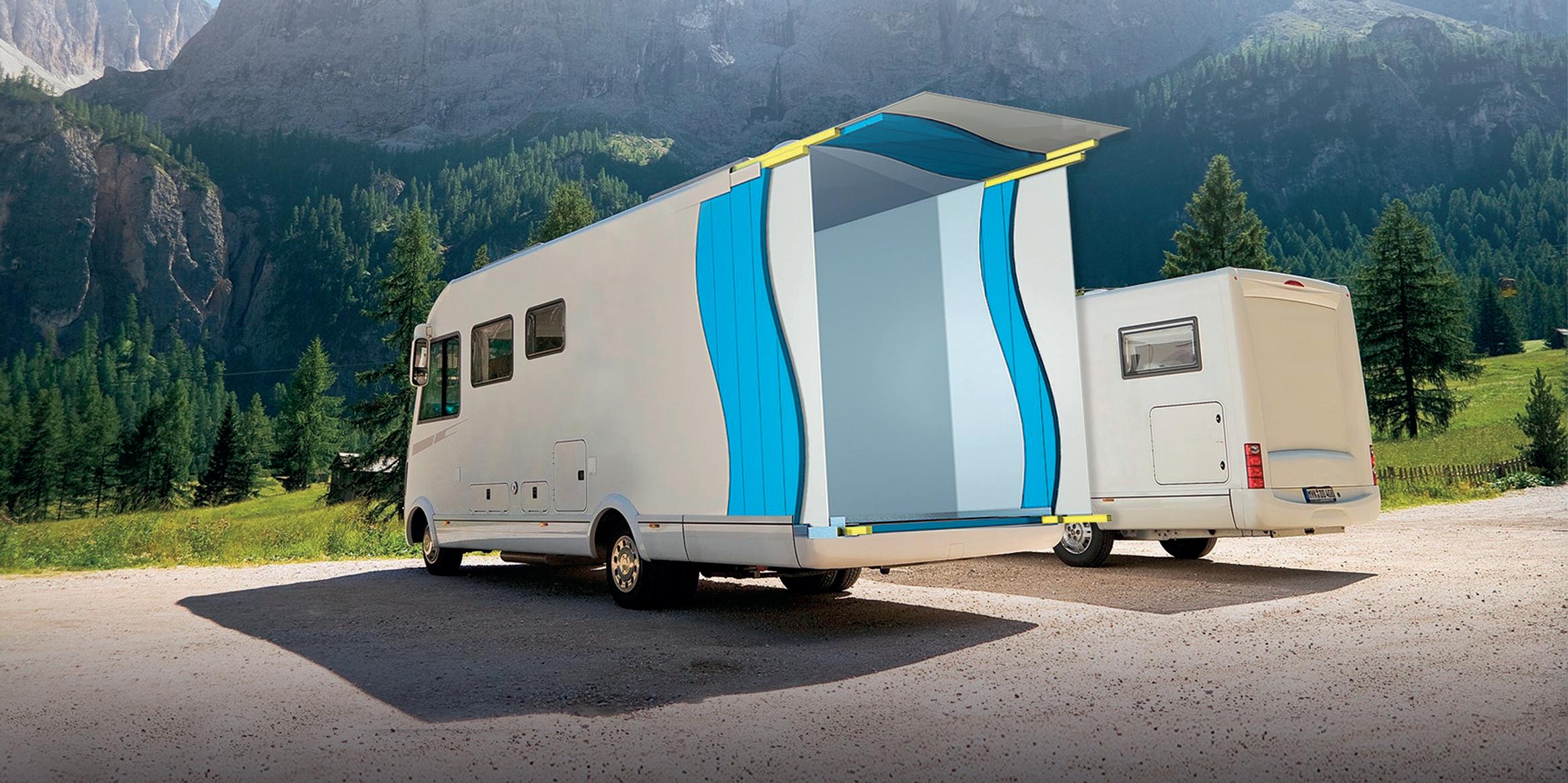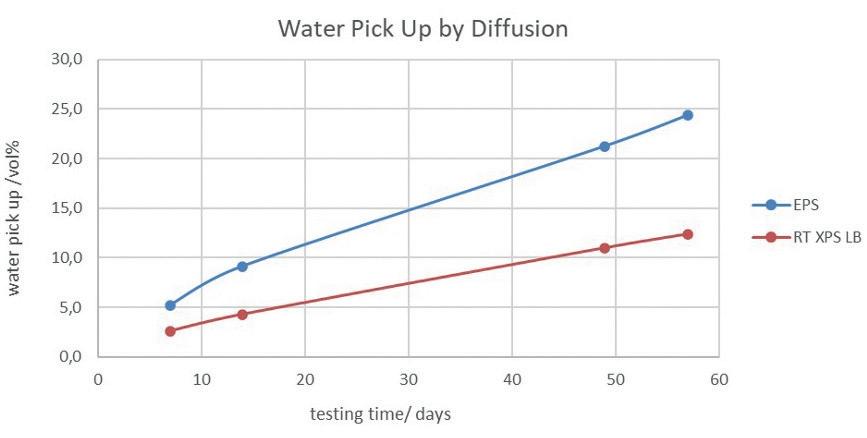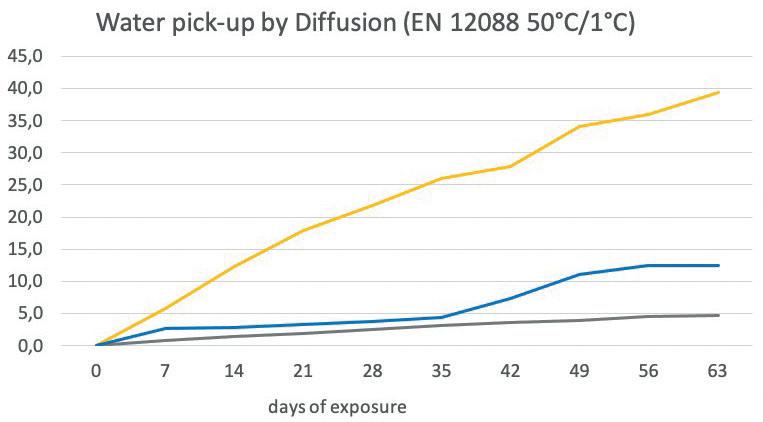
7 minute read
Ravago
The content matters
RAVATHERM XPS features at a glance
• Energy efficiency and Thermal insulation • High water and vapour resistance • Long-Term proven performances • High Mechanical performances • Lightweight • Easy to use
The importance of choosing the right core material for sandwich panels
When manufacturers of motorhomes and caravans build the walls, floors and ceilings of their vehicles, they know that as structural elements they need to withstand a wide variety of loads and weathering conditions over several years vehicle’s life time. Selection and quality of the materials used are critical for the overall performance and longevity of the vehicle; as the core material within the composite panels has significant impact on: • insulation performance • damp and moisture resistance • overall assembly strength. RAVATHERM XPS core material for sandwich panels produced by Ravago Industry Solutions has numerous benefits and in particular helps achieving the best insulation performances, while keeping moisture at negligible levels. Why this? The blue and the grey XPS foam panels have a closed cell structure which gives them excellent insulating properties, long-term moisture resistance as well as high mechanical strength. Let’s have a look at how RAVATHERM XPS matches the specific demands of the motorhome and caravan industry leaders compared to alternative core materials in particular concerning moisture uptake.
Foam cores
The main materials used in leisure vehicle industry are extruded Polystyrene (XPS) foams, as well as some Polyurethane (PU) and Expanded Polystyrene (EPS).
Tests results
The tests conducted in Rheinmünster (Germany) central laboratory of Ravago Building Solutions and confirmed by independent European laboratories, are highlighting significant behaviour differences specifically in wet environment.

Water pick up test (EN 12088)
The graph below is a side-by-side comparative testing of RAVATHERM XPS LB blue and high quality “moisture resistant” EPS. Bath temperature 50°C. Samples’ thickness 30-mm. Physics fundamentals: • Heat and vapour flows are moving through a panel from the warm side to the cold side. • Vapour is the moisture content in the air. Moisture content could be high in confined spaces in particular in wet rooms as bathrooms, toilets, kitchen corners; and is also generated by the breathing of people or animals. • If temperature of the room or of the surfaces is above the dew point, humidity content in the air will condense into water. • Vapour may travel through a panel using surface porosity of the warm side or via openings / joints even extremely small.
While going through the panel, the temperature will decrease and may lead to condensation inside the core material.
Vapour flow may also be blocked whenever cold side is more vapour tight than warm side of panel.
All this will lead to accumulation of water in the panels’ core, which will eventually lead to an increased weight of the panel, rotting, mold development, and even icing if in cold climates.
The mechanical action of icing will further damage the panel’s structure accelerating the phenomenon.
Tests: The test has been extended to 2 months to illustrate a typical lifetime of a vehicle used in various climates and conditions.The homogeneous closed cell structure of XPS is showing limited water diffusion through the cell walls. With XPS the process is affecting primarily the area next to entry point and is propagating very slowly. As a consequence if the entry point is limited only a minor portion of XPS core material will be involved; unlike the opened beadsstructure of expanded polystyrene – EPS - where vapour will rapidly diffuse through the entire EPS panels via the voids in-between the beads: even with

WPU by diffusion testing time /days 7 14 49 57
EPS Water Pick Up /vol % 5.2 9,1 21,2 24,4 LB Water Pick Up /Vol % 2,6 4,3 11,0 12,4 94
minor entry point full panel will be affected. The graph is self explanatory: after 60 days, EPS is showing about 25% water uptake!
Water retention test A comparative testing between EPS and PU.
Graph 2 below is a side-by-side testing of EPS and PU. • 65°C bath temperature • PU = 35/40 kg/m3 • 40-mm PU and 50 mm EPS thickness • Test stopped after about 60 days since water saturated PU collapsed by its own weight into water bath

EPS water uptake is accelerated as expected by bath water temperature. EPS is otherwise showing normal behaviour as described in previous comparative test. PU is showing extremely rapid diffusion through entire foam block due to very high affinity of vapour with PU chemistry. In a second phase, we witnessed hydrolysis of PU structure in presence of moisture leading to permanent and total loss of any mechanical integrity, not even considering freezing impact.
A close up image of EPS beads and XPS closed cells structures is illustrating at a glance the advantages using XPS as core materials for sandwich panels:
Water retention test A comparative testing between XPS and PU
As final test, RAVATHERM XPS X RTM – RAVATHERM XPS LB and PU product have been tested and results, as expected, showed the difference between XPS and PU performances: • 50°C bath temperature • PU = 50 kg/m3 Significant diffences in the performance after 63 days: while PU product shows a water retention of nearly 40% at 50°C bath temperature, the RAVATHERM XPS of Ravago Building Solutions shows a performance that stays well behind 15%. The best performances show the grey product RAVATHERM XPS X RTM, with a water uptake of only 4,7%.
Summary
The moisture resistance of the core layer material can have a significant impact on the durability of the overall structure of a composite panel, as well as affecting long term insulation performance. Moisture in core insulation materials has a negative effect on thermal insulation properties and can contribute to the development of rotting and mold. Additionally, trapped moisture conducts heat 25 times better than air. Moisture can penetrate via very minor entry points to the core layer material by diffusion and condense. Damage to outer layers will also accelerate to moisture accumulating in insulation material. As well as good thermal performance, RAVATHERM™ XPS provides high moisture resistance, ensuring a consistently good thermal performance over entire vehicle lifetime. EN 12088 (determination of long term water absorption by diffusion) standard is used to determine the water vapour resistance. RAVATHERM™ XPS products with their closed cell structure pick up very little amount of water. As a result, the thermal conductivity of RAVATHERM™ XPS doesn’t change significantly after the water pick-up by diffusion test compared to the thermal conductivity measured after storage under dry conditions. RAVATHERM™ XPS foam, is the peace of mind of having selected the market best-performing insulation for your motorhome or caravan. Mold is the most common problem in a motorhome or caravan. Noone wants to see – or smell – mold on or into walls, floors or ceilings. Keeping moisture out is vital to protect the long-term performance and comfort of caravans and motorhomes. Water vapours released by showers, cooking, drying laundry, people and pets breathing, will increase moisture content in the air. Without regular ventilation, this moisture will condense on panels’ surfaces or – worse –, diffuse in the form of water vapour within the composite panels and condense there causing bad smells and mold and affecting long term performances. Wet insulation materials will not perform same as dry ones, thus rising heating or air-conditioning running costs of the vehicle. Wet core material with 10% moisture can lose up to 45% of its insulation performance.
On the left, picture 1: EPS beads’ structure. Picture 2 XPS closed cells’ structure
Sample PU 50kg/m3 RAVATHERM XPS X RTM RAVATHERM XPS LB
days of exposure
0 7 14 21 28 35 42 49 56 63
Vol - % Vol - % Vol - %
0,0 5,8 12,4 17,9 21,9 26,0 27,8 34,2 36,0 39,4 0,0 0,8 1,4 2,0 2,5 3,1 3,5 4,0 4,5 4,7 0,0 2,6 2,8 3,3 3,8 4,3 7,3 11,0 12,4 12,4
About Ravago Building Solutions
The Ravago group, a fast-growing multinational company with a culture based on family values. Founded in Belgium in 1961 the company is committed to ethical and sustainable business practices and forges strong relationships with its 7,000-strong workforce and 49,000 customers. As part of the Ravago Building Solutions business unit, Ravago Industry Solution manufactures and distribute specialized industrial products across Europe, Turkey, and CIS markets. Main application field of Ravago Industry solutions is the production of the XPS core material for Caravans, motorhomes and refrigerated trucks. RAVATHERM™ XPS is the name for the blue and grey foam boards which have been used for many years in such industrial applications; RAVATHERM™ XPS foams offer engineers and technical designers the confidence and the assurance that the most demanding of design specifications can be met. For further info: www.ravagobuildingsolutions.com/industry











